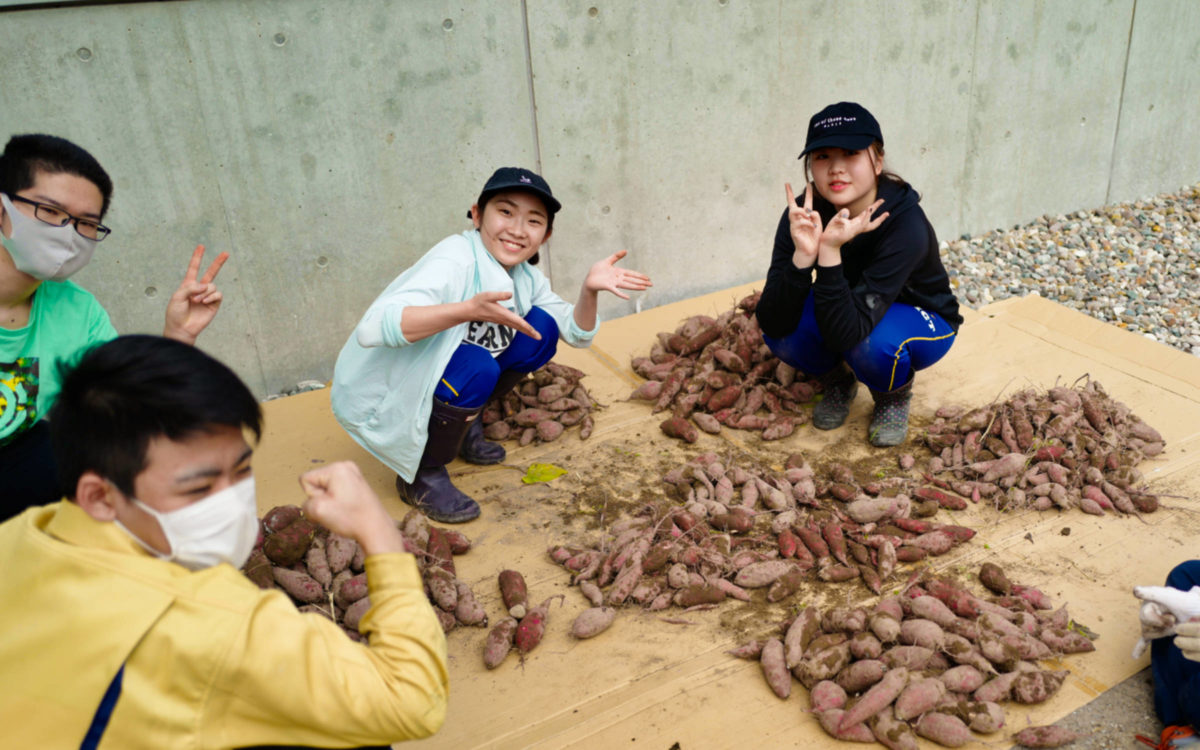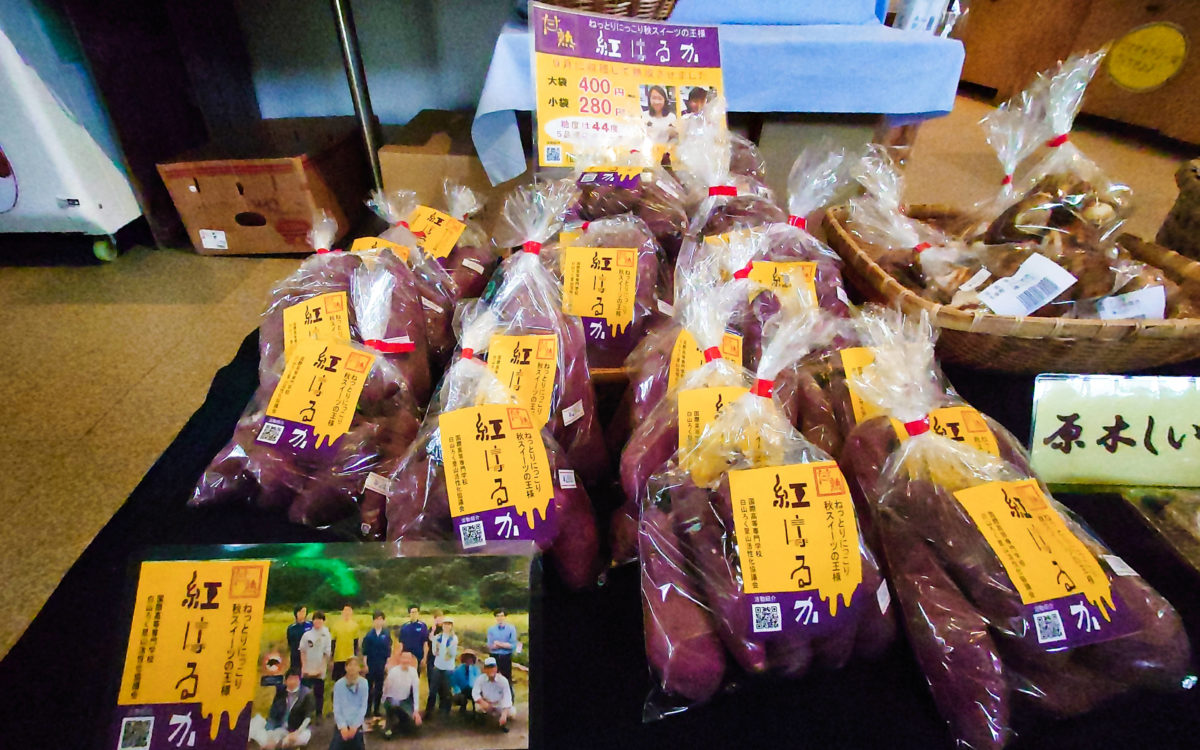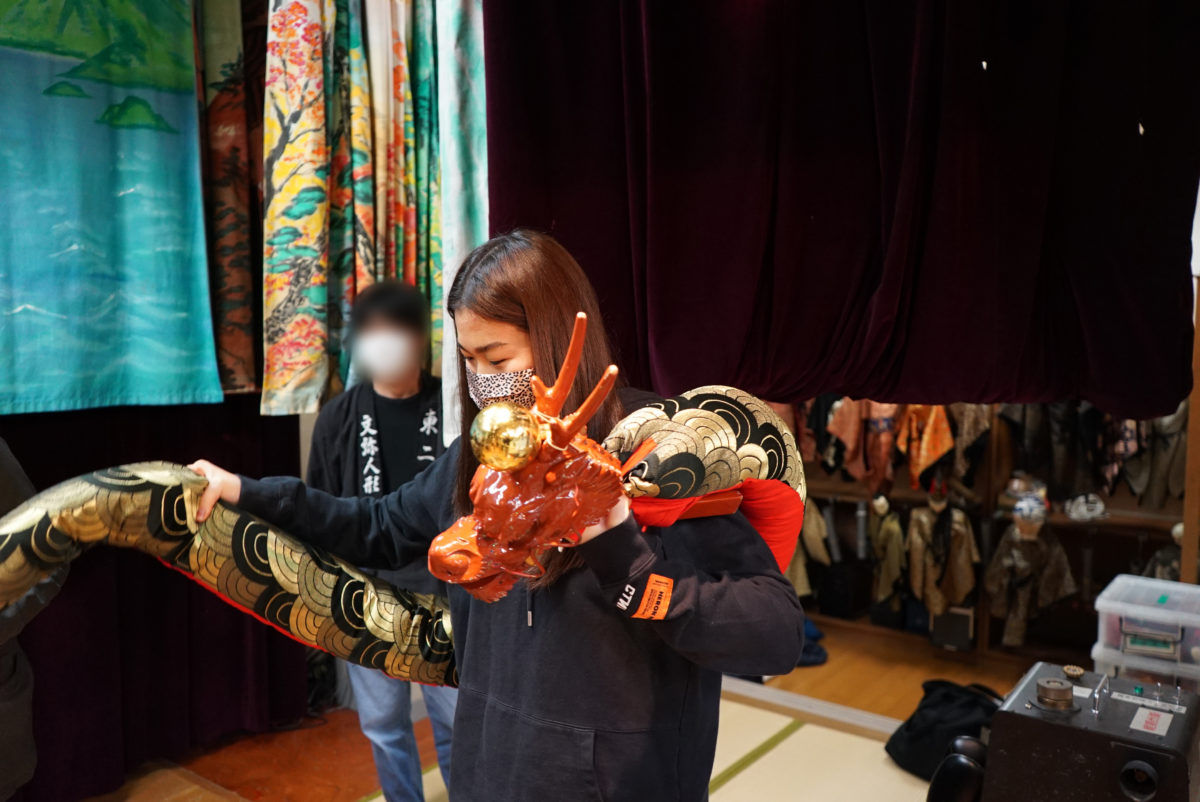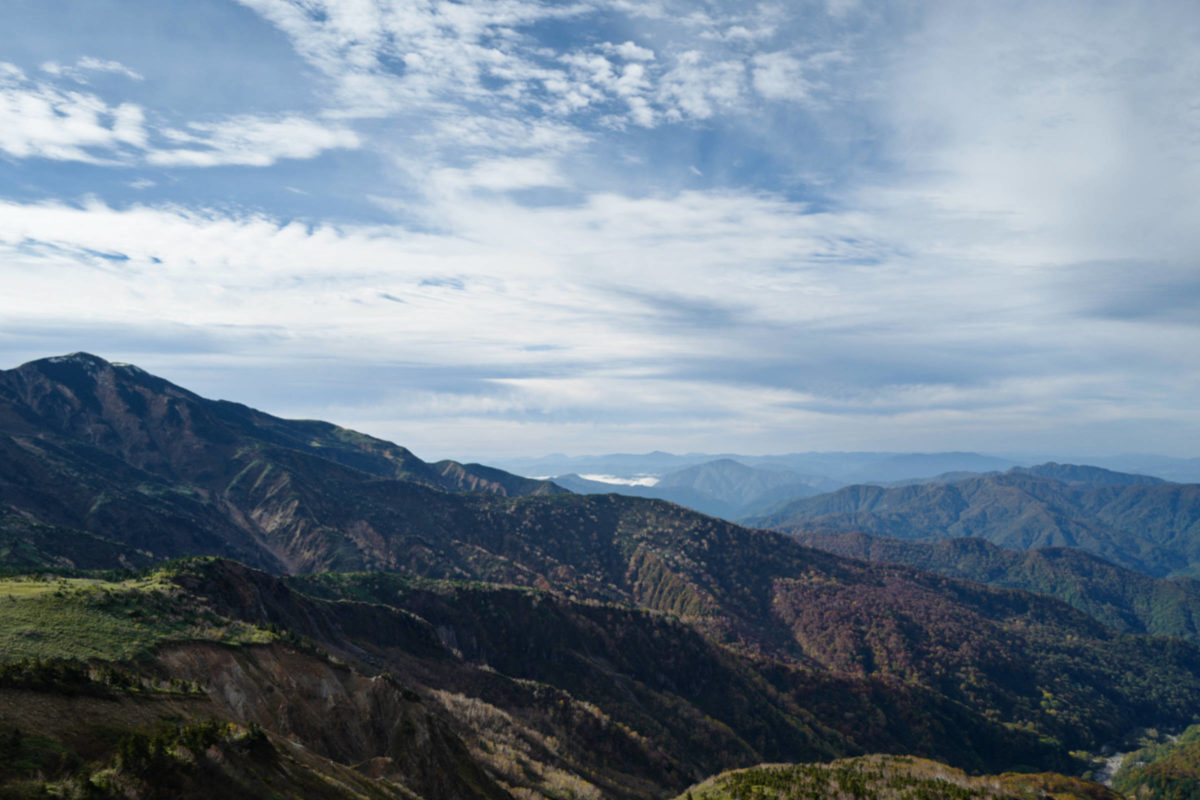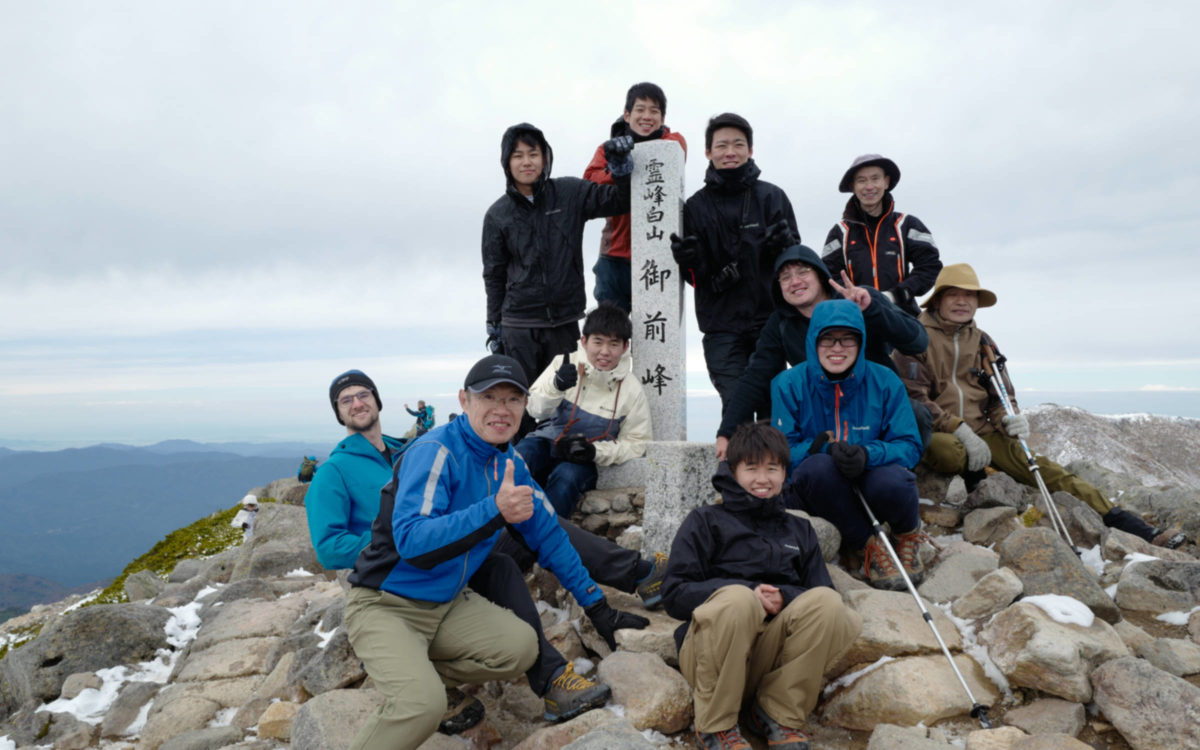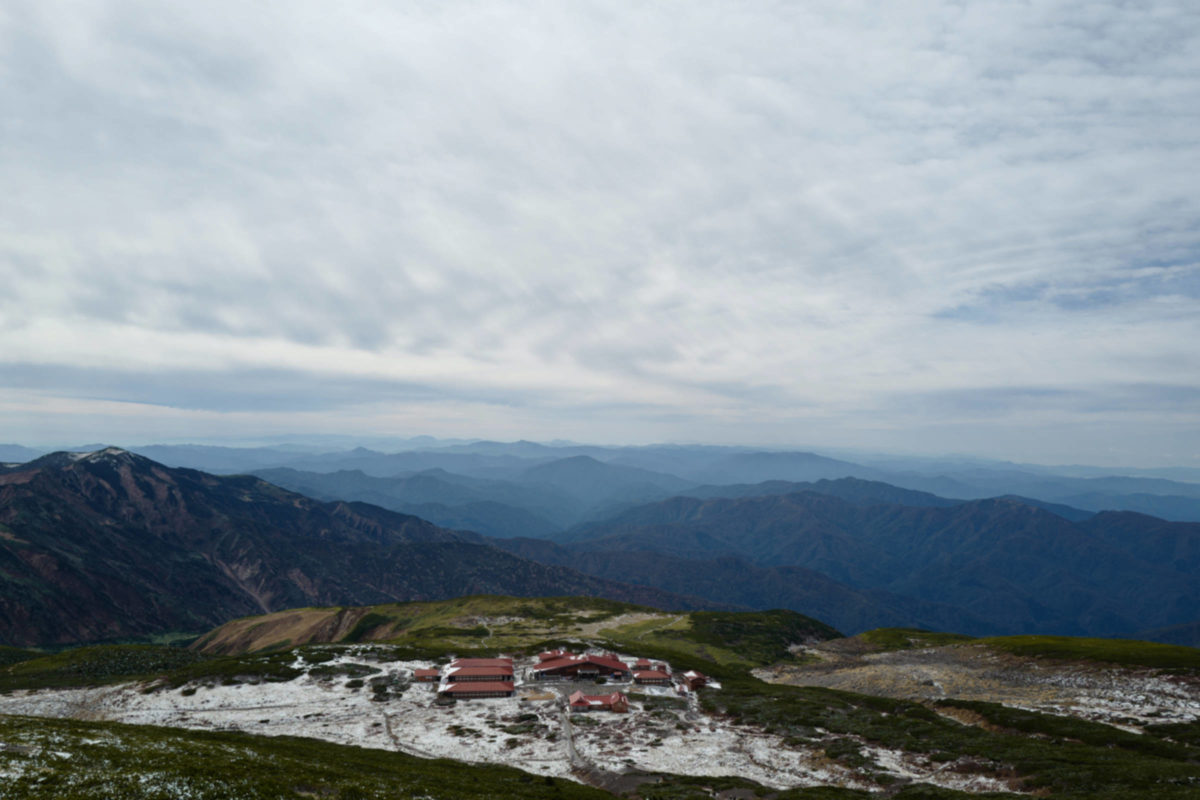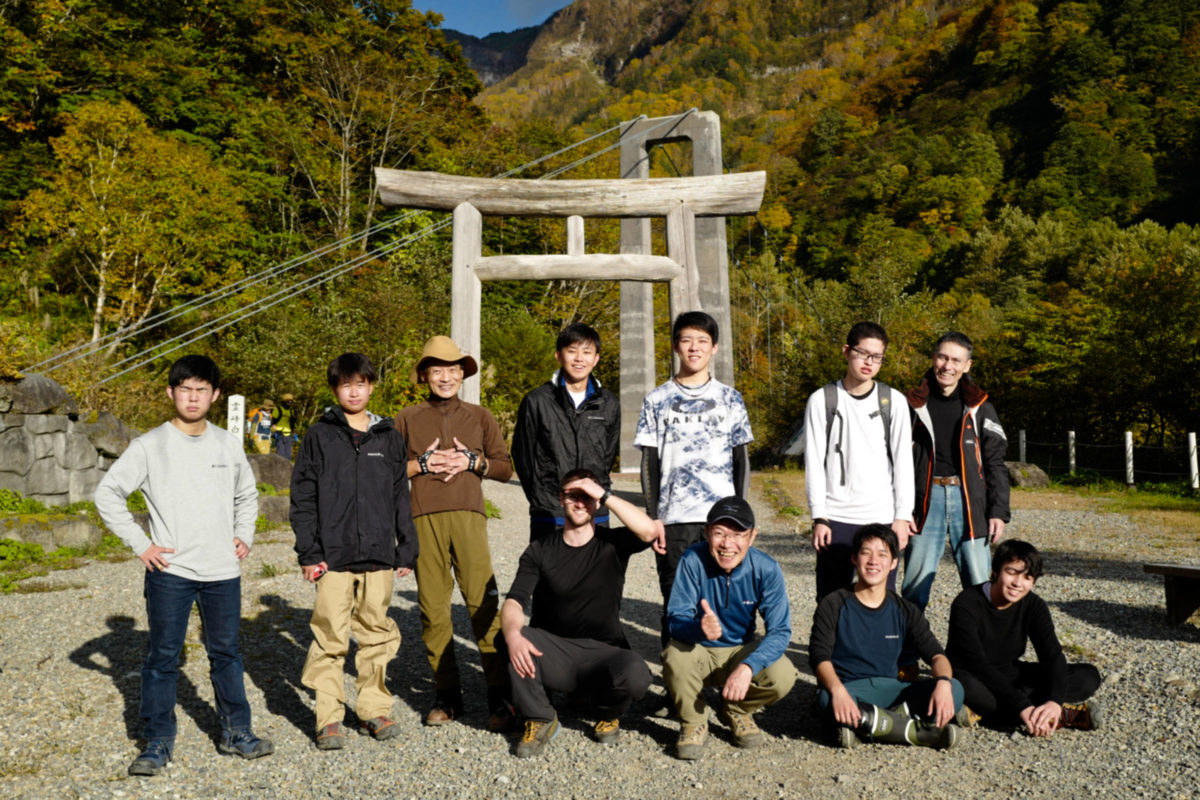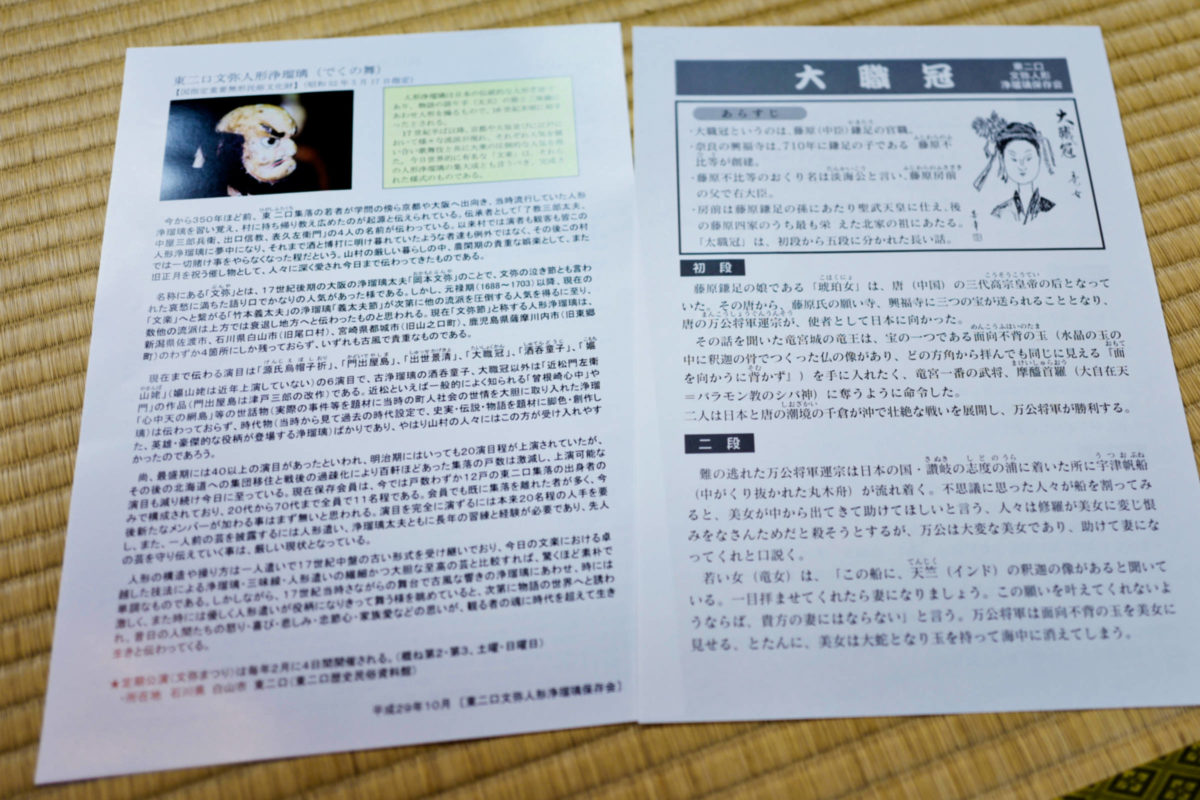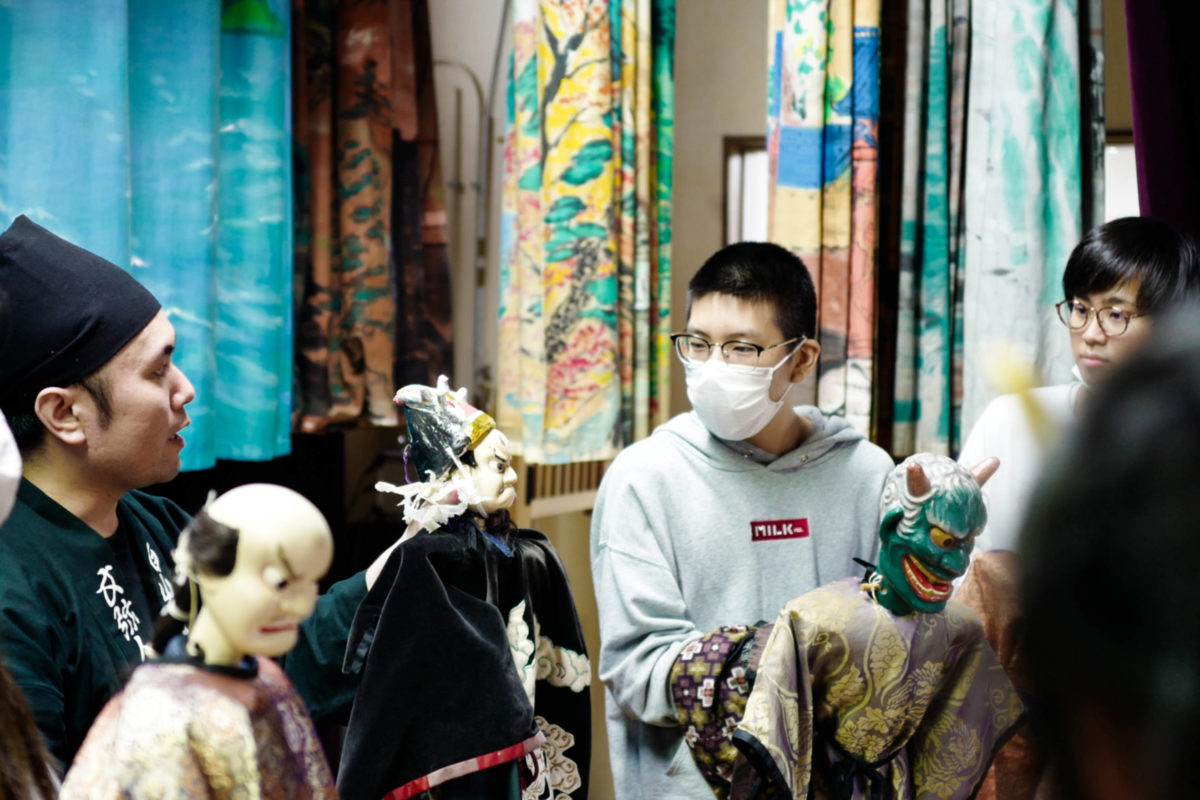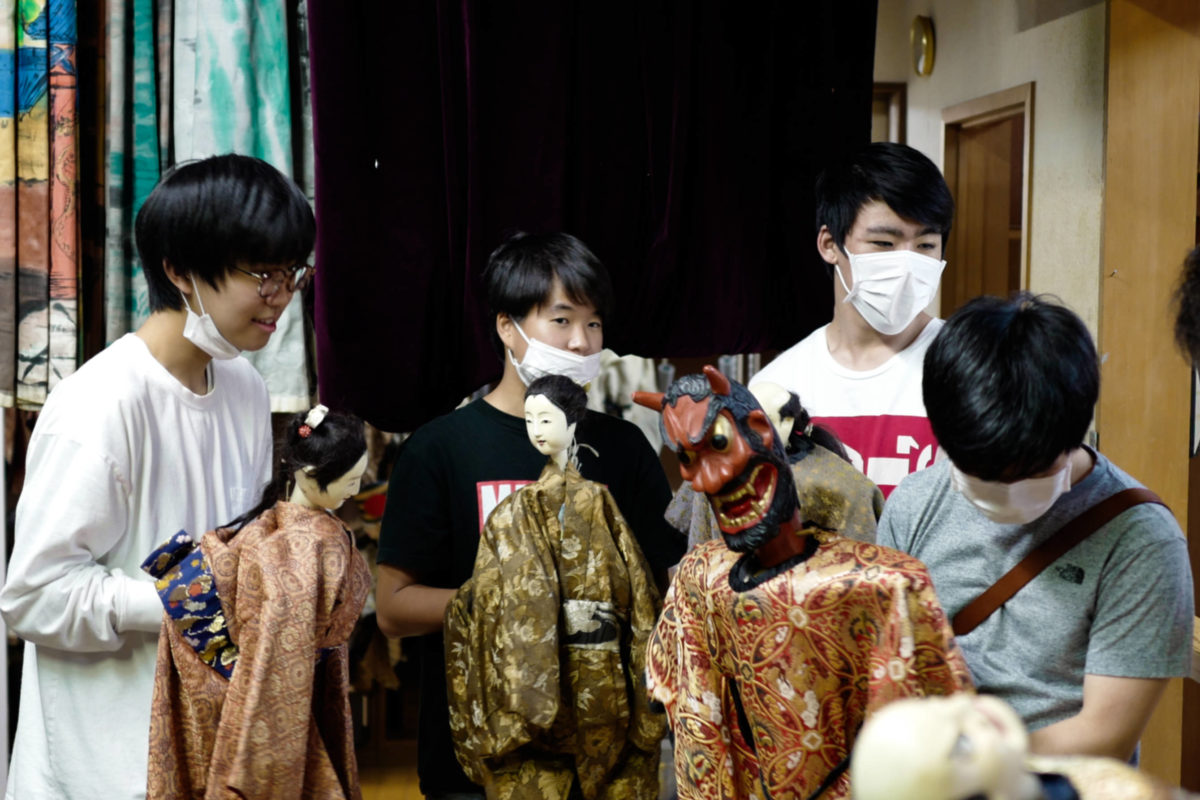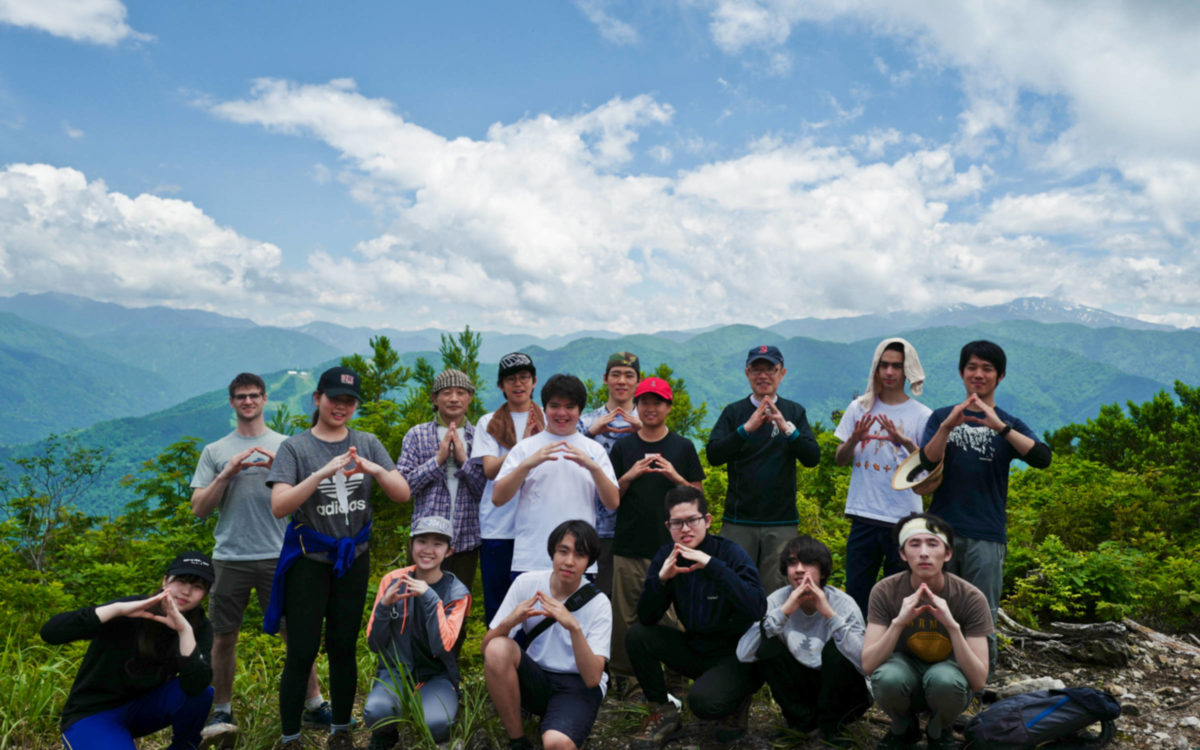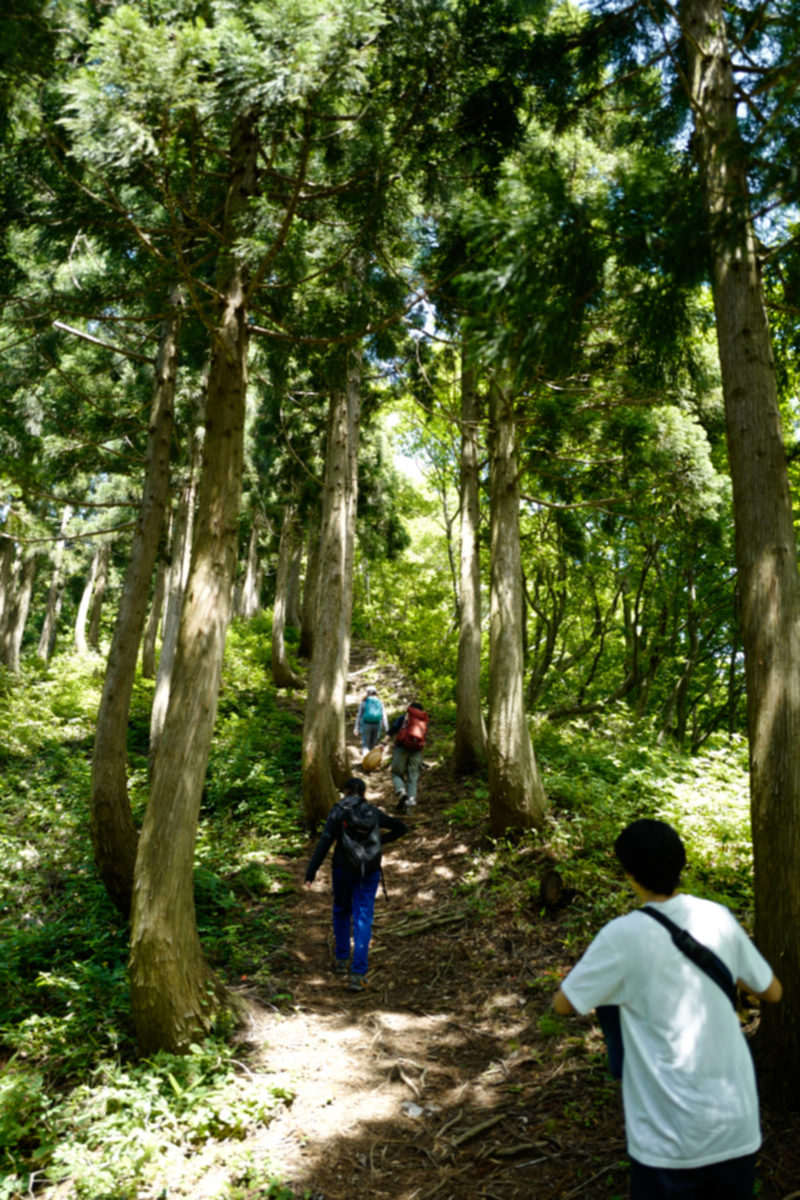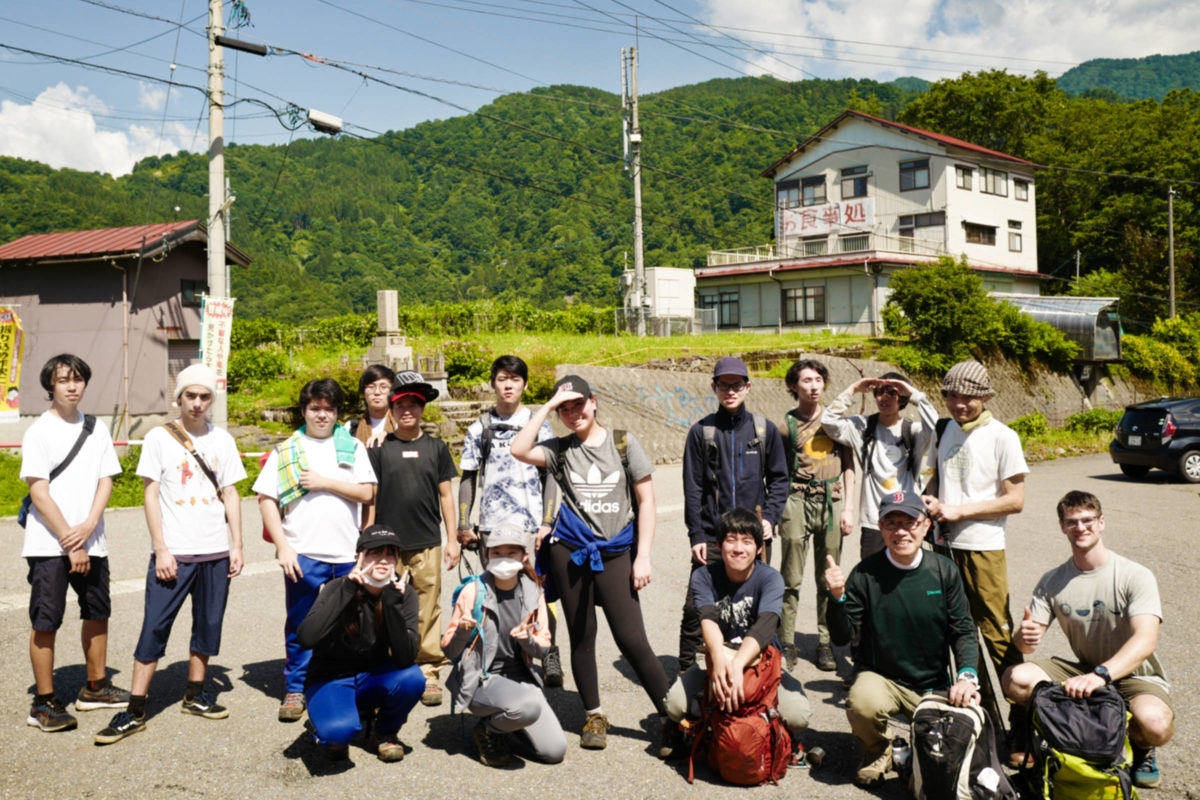Hakusanroku Journal 白山麓ジャーナル:Local Community
November 30, 2020 愛・AIいもプロジェクト
 カメラマンのジョナサンです!今日は2年生の「エンジニアリングデザイン」の活動を紹介します。
カメラマンのジョナサンです!今日は2年生の「エンジニアリングデザイン」の活動を紹介します。
国際高専の問題発見解決型の授業、「エンジニアリングデザイン」では、学生がユーザーの視点に立って課題を明確化、解決策のアイデアを考慮しプロトタイプを作っています。今年は2年生7名が白山麓キャンパス校舎前の休耕田に着目して、「アグリテック班」「アグリビジネス班」の2つのグループに分かれて課題解決に挑みました。
昨年、課外活動の一環で、一部の学生と先生が白山麓キャンパス前にある休耕田でさつまいもを栽培しましたが、サルにより収穫のほとんどを奪われてしまいました。金沢工業大学と連携して、大学の研究室で試作された獣害対策ロボットを試しましたが、風などで動きのある自然を背景にした場合、動物の認識率が低いことがわかりました。そこで「アグリテック班」はAIを使って自然の中でもサルを認識できるシステムの開発を行うことにしました。後学期はプログラム開発を進め、11月に入ってからは津幡町にある石川県森林公園で、ニホンザルの写真を7,000枚撮ってシステムに学習させて認識の精度を高めました。これらの活動は11月13日(金)にNHK金沢放送局の「かがのとイブニング」にも取り上げられました。農作物の被害は全国的な課題となっており、今後は畑にサルが侵入した際に、所有者のスマートフォンに知らせるシステムの構築を目標にしています。
「アグリビジネス班」の学生たちは地域活性化を図るために「愛・AIいもプロジェクト」を4月に発足し、休耕田にさつまいも「紅はるか」の植え付け、草むしり、収穫を自ら行いました。今年は電気柵を使ってサル対策をしたおかげで栽培した芋の9割以上を収穫できました。学生たちは糖度計を使って収穫した紅はるかの糖度を計測したところ44度という非常に高い数値を確認し、焼き芋にするとねっとりと甘く、大変美味しいことがわかりました。学生たちは芋を洗ってから大きさごとに分別し、オリジナルデザインのラベルを貼って販売用にパッケージングを行いました。白山麓発のブランド化を目指して「甘熟紅はるか」と名付けられたこれらのさつまいもは道の駅「瀬女」や地元のスーパーで販売したところ、すぐに在庫がなくなるほどの人気でした。
次年度以降は、「アグリテック班」が開発した獣害対策システムの完成度向上を計りながらブランドのさつまいもの生産販売を地域と協力しながら推進する予定です。
ジョナサン
Hi, its Jonathan the cameraman. Today, I will give a report on what some of the second year students have been doing in "Engineering Design" class.
ICT's "Engineering Design" is a course in which students find problems in their community or society by interviewing people and creating prototypes that solve them. Seven of this year's second year students decided to focus on the unused fields across the street from the Hakusanroku Campus and start the "Ai Ai Imo Project", which consists of two groups: "Agri-tech" and "Agri-business".
Last year, some students planted sweet potatoes in the same field as part of their club activity. Despite their hard efforts, most of the potatoes were dug up and eaten by monkeys. They partnered with Kanazawa Institute of Technology to test a wild animal defense robot. However, it proved unable to detect animals when set in a wild environment due to wind moving the plants in the background. Learning this, the "Agri-tech" group decided to create a system that detects monkeys in the wild using AI. The actual construction of the system started this semester. In November, they traveled to the national park in Tsubata-machi and took over 7,000 pictures of the monkeys there to increase the accuracy of the AI. These activities were even featured on national television "Kaga-noto Evening" on November 13. Damage to crops by wild animals is a serious problem in Japan and the group hopes to develop a system that can detect monkeys entering a field and notify the owner via their smartphone.
The "Agri-business" group started the "Ai Ai Imo Project" in April. Their goal was to utilize the unused field to grow and sell sweet potatoes. To not repeat the same mistake as last year, this year's second year students built an electric fence around the patch to shut out the monkeys. Thanks to this and some quick decisions, they were able to harvest over 90% of the sweet potatoes. Students measured the sugar content of the potatoes, which turned out to be a remarkably high 44 degrees. After roasting and eating the sweet potatoes, we confirmed that they were rich, sweet and delicious. The students rinsed and separated the sweet potatoes by size, which they then packaged and labeled. These sweet potatoes were branded "Kanjuku (sweet and ripe) beni-haruka" and were sold at the michi-no-eki "Sena" souvenir shop and local super market "Yorankaine". They were extremely popular and sold out in a couple of days.
Next year, we hope to improve the system created by the "Agri-tech" group and work with the local community to further promote the sweet potatoes to draw people to Hakusanroku.
November 24, 2020 伝統芸能に触れる
 国の重要無形文化財に登録されている白山麓地域の伝統芸能の人形浄瑠璃「でくのまわし」をテーマとしたプロジェクトを思案している2年生のグループがある。彼らは、前期授業で地域調査をはじめ、この地域ならではの価値について考えた。後期授業では、導きだした価値を活かしたプロジェクトを考えている。
国の重要無形文化財に登録されている白山麓地域の伝統芸能の人形浄瑠璃「でくのまわし」をテーマとしたプロジェクトを思案している2年生のグループがある。彼らは、前期授業で地域調査をはじめ、この地域ならではの価値について考えた。後期授業では、導きだした価値を活かしたプロジェクトを考えている。
11月15日には、徳島の浄瑠璃団体の座長として活動されているマーティン・ホルマンさんによる人形浄瑠璃講演を白山市東二口歴史民俗資料館で聞くことができた(白山市国際交流協会主催)。ちなみに以前のジャーナルにも掲載されていたが、彼らの東二口への訪問は2回目となる。今回の目的は、浄瑠璃の理解をより深める事と、学生たちが思案しているプロジェクトについて、演じる方に意見を伺うことである。
講演はホルマンさんの人形浄瑠璃に関わるきっかけや、人形の操り方、人形浄瑠璃をどのように思っているかなど、いろんな角度からお話を聞くことができた。日本人でない方が日本の伝統芸能に情熱的に関わっている姿に、感慨深いものを感じた。講演後には、東二口の演目である大職冠の一部を鑑賞した。学生は徳島の人形を動かす機会もあり、地域の演技特徴を比べながら人形浄瑠璃について深く知る機会を得た。
企画後に学生達は、ホルマンさんや東二口の方々と交流を図っていた。今回の交流を通じて得た情報、感じた事は学生達の考え出したプロジェクト案に反映され、より充実した内容になることが期待できる。
小高有普
One group of second year students have started a project targeting the local "important intangible cultural property", traditional performing art here in Hakusanroku, the puppet theatre "Deku-mawashi". In the first semester, they gathered information from the local community and evaluated its unique importance. Currently in the second semester, they are working on a project to improve its situation.
On November 15, we were able to listen to a lecture by chairman of Ningyo-joruri (traditional puppet theatre) in Tokushima prefecture, Martin Holman at the folk museum in Higashi-futakuchi, Hakusan city (the event was organized by Hakusan International Asosiation). You may have read the previous journal entry and know that it is the students second time to visit here. Our goal this time was to deepen our knowledge of Ningyo-joruri and ask the performers for feedback on the students' proposal.
Listening to the lecture by Mr. Holman, we learned how he got involved with Ningyo-joruri, how to operate the puppets, and what his opinion is about the art. It was moving to listen to a foreigner speak so passionately about Japanese traditional art. After the lecture, we watched a part of the play "Taishokukan" and students were able to touch some of the puppets from Tokushima. It was informative and interesting to compare the differences between Ishikawa and Tokushima.
After the event, students continued to gather information from Mr. Holman and the Higashi-futakuchi members. The knowledge and feedback they gathered will improve their project even further.
Arihiro Kodaka
October 20, 2020 Mt.Hakusan Climb
 こんにちは、カメラマンのジョナサンです。2020年10月18日(日)、ネイチャー&アドベンチャークラブの白山登山に同行してきました。白山は石川県と岐阜県にまたがる標高2702mの活火山で、富士山と立山と並んで日本三霊山のひとつです。ネイチャー&アドベンチャークラブでは白山登山が恒例行事となっていますが、今年は9月の予定日が台風と重なってしまって18日が最後のチャンスだったのですが、ありがたいことに天候にも恵まれて実施ができました。私たちは早朝5時に玄関前に集合し、登山口の別当出合へ移動しました。前日17日に白山の初冠雪が報道されたためか、たくさんの登山客が来ていました。
こんにちは、カメラマンのジョナサンです。2020年10月18日(日)、ネイチャー&アドベンチャークラブの白山登山に同行してきました。白山は石川県と岐阜県にまたがる標高2702mの活火山で、富士山と立山と並んで日本三霊山のひとつです。ネイチャー&アドベンチャークラブでは白山登山が恒例行事となっていますが、今年は9月の予定日が台風と重なってしまって18日が最後のチャンスだったのですが、ありがたいことに天候にも恵まれて実施ができました。私たちは早朝5時に玄関前に集合し、登山口の別当出合へ移動しました。前日17日に白山の初冠雪が報道されたためか、たくさんの登山客が来ていました。
準備ののち、6時半に登山を開始しました。早朝の空気は冷えていましたが、中飯場に到着する頃には上着を脱ぐほどに温まっていました。甚之助避難小屋付近では紅葉が始まった山々のパノラマが見られるようになり、学生たちは双眼鏡やカメラを使って眼中に収めていました。参加した学生のほとんどが初の白山登山で、苦しい時間もありましたがペースを調節したり声を掛け合いながら奮闘しました。黒ボコ岩を越えた弥陀ヶ原からはスカッと晴れた空をバックに御前峰が見えました。室堂に近づくと雪の出現とともに本格的に冷えてきました。全員防寒具を装着して最後の登りに臨みました。
室堂の先は気温が一気に氷点下に下がりました。風も強くなり、体感気温は真冬の雪山のようでした。頂上に到着した私たちを待っていたのは雪化粧がされた御前峰と、能登半島まで見渡せる澄み切った空でした。登頂時刻は11時頃でした。寒さで体力の消耗が激しかったので滞在時間が限られていましたが、学生たちは景色を見たり、叫んでみたりして石川県のてっぺんを堪能しました。室堂に戻ってからは昼食をとり、下山しました。黒ボコ岩まで戻ると気温も上がり、涼しいと思えるようになりました。別当出合に到着したのは15時半頃で、最後の集合写真を撮りました。辛かった者、余裕だった者、楽しかった者、様々でしたが全員が日常生活を離れ、普段見れない景色、できない体験をした貴重な一日となりました。
ジョナサン
Hello! It's Jonathan, the camera man. On October 18, 2020, the Nature & Adventure Club held their annual Mt. Hakusan climb. Mt. Hakusan means "white mountain" in Japanese and is located across Ishikawa prefecture and Gifu prefecture. It is 2702m high and is one of Japan's three sacred mountains along with Mt. Fuji and Mt. Tateyama. The Nature & Adventure Club was scheduled to climb Hakusan in September but this was canceled because of a typhoon. October 18 was our last chance and we were rewarded for our patience with perfect skies. We gathered at front entrance of the Hakusanroku Campus at 5 am and drove to Betto-deai, the starting point on the Ishikawa prefecture side. It just snowed for the first time this year on the day before, and the parking lot was full of climbers, possibly prompted by the news.
We began our assent around 6:30 am. It was chilly at first but warmed up as the sun came up. The leaves were beautifully colored with many reds, oranges, and yellows. After Jinnosuke Cabin, the scenery opened up and we could see the panorama of mountains surrounding Hakusan. Students enjoyed this view, some with cameras and binoculars. For most of the students, this was their first time climbing Mt. Hakusan and the going was not always easy. However, students pushed on at their own pace. After Kuroboko-iwa, we could see the white peak across from Mida-ga-hara, with a blue sky background. The temperature began to decline as we approached Murodo. There, we geared up and made the final climb to the peak, Gozen-ga-mine.
The temperature dropped below 0 degrees celsius past Murodo and wind felt like a blizzard in mid winter. When we finally reached the top around 11 am, we were greeted by a freshly coated Gozen-ga-mine and blue skies so clear that you could see Noto peninsula in the distance. We enjoyed the awesome view as long as we could bear. Some students even began shouting for the fun of it. After returning to Murodo, we all ate lunch and began our decent. Temperatures finally rose again after Kugoboko-iwa and we could appreciate to cool breeze. We arrived at Betto-deai around 3:30 pm, concluding our trip with a group photo. The students' reactions to the experience differed. Some enjoyed it, some found it easier than they expected, and some vowed to never do it again. In any case, it was an unique opportunity to see new sites and try something new.
Jonathan
September 30, 2020
 秋来ぬと目にはさやかに見えねども風の音にぞおどろかれぬる
秋来ぬと目にはさやかに見えねども風の音にぞおどろかれぬる
(秋が来たと目にははっきりと見えないけれど、風の音で気づいたよ。)
古今和歌集 秋歌上 藤原敏行
こんにちは。国語科のKTBです。猛暑の夏がやっと終わり、朝晩には涼しい風を感じます。白山麓では秋風に乗って舞い降りてきたアサギマダラの、藤袴の蜜を求める華麗なワルツが今年も見られるようになりました。夏は白山の室堂辺りで涼んでいるのだそうです。


9月22日には公民館主催のマーキング調査会が開催され、ICTからは山崎俊太郎先生と事務局の渡邊晶子さん、そして私の3名が参加しました。昨年度までICTの学生寮のRAを勤めていらした山下和樹さんが公民館からお世話に来てくださいました。


解説はアサギマダラファンクラブ白山代表の中村明男さん。右奥が山下和樹さん。
マーキング調査とは、旅する蝶アサギマダラが、どのようなコースを、どれくらいの日数をかけて、どこまで飛んでいくのか、などを調べるために、捕まえて、羽にマーク(標識)を付けて放し、遥か海の向こうで再び誰かに捕まえてもらうというものです。去年はこの白山でマーキングした蝶が2頭(蝶は「頭」で数えます。珍しい昆虫なども飼育している西洋の動物園でのheadという数え方がその由来だそうですが。)、台湾まで飛んだそうですよ。
マーキングの方法は、虫取り網でまずはアサギマダラを捕らえます。手で触ると死んだふりをして動かなくなるので、羽に油性ペンで、白山(捕獲場所)・9.22(日付)・YK(私のイニシャル)・01(何番目に捕獲したものか)と記入します。私は9時から11時までで5頭の捕獲に成功しました。マーキングを終えると写真を撮ります。しばらくすると死んだふりをやめて、再び藤袴の蜜を求めて飛び立ちます。

死んだふりをして手を離しても動かないアサギマダラ(5頭目)。下羽に黒い斑点があるのは雄です。どこまで飛んでいくのかしら。がんばれよ。じゃあまたね。
潟辺豊
秋来ぬと目にはさやかに見えねども風の音にぞおどろかれぬる
You cannot tell to the eye that autumn has come, but I suddenly noticed it by the sound of the wind.
Kokin-waka-shu Fijiwara-no-Toshiyuki
Hello, it's your Japanese teacher, KTB. Finally the scorching summer has ended and I can feel the cool breeze in the morning and evening. At Hakusanroku, it's the season when the chestnut tiger butterflies arrive on the autumn wind and dance around the thoroughwort flowers. I hear they spend the hot season near Mt. Hakusan's pear.
The annual marking investigation event hosted by the community center was held on September 22 and Shuntaro Yamazaki sensei, Shoko Watanabe san from the office, and myself participated from ICT. We also met our former RA, Kazuki Yamashita san there.
Akio Nakamura san, Hakusan representative of the Chestnut Tiger Butterfly Fan Club gave an explanation. You can see Kazuki Yamashita san standing on the right.
Marking investigation is the measurement of how far a butterfly travels, what route it takes, and how many days it takes. You catch a butterfly and release it after marking its wings. Then, someone on the other side of the ocean will find it. Last year two butterflies marked here were found all the way in Taiwan.
To mark a chestnut tiger butterfly, first catch one with a net. They will play dead once you touch them so write "Hakusan" (place), 9.22 (date), YK (my initials), and 01 (number of butterfly you caught). I caught five butterflies between 9 and 11 am. After you are done, take a picture. Soon they will stop playing dead and fly away in search of more thoroughwort nectar.
The third picture is the fifth Chestnut Tiger butterfly I caught playing dead. Males have black patch on bottom wing. Don't know where you're going, but safe travels. Hope to see you again.
Yutaka Katabe
September 25, 2020 永光寺報告文
 令和2年9月5日(土)午前、3年生11名が必修科目「生活と文化」の一環として、担当教員の札野先生、ポーリン先生の引率のもと、石川県羽咋市にある洞谷山永光寺を訪問し、境内見学および参禅体験を行いました。
令和2年9月5日(土)午前、3年生11名が必修科目「生活と文化」の一環として、担当教員の札野先生、ポーリン先生の引率のもと、石川県羽咋市にある洞谷山永光寺を訪問し、境内見学および参禅体験を行いました。
洞谷山永光寺は、曹洞宗の太祖である瑩山紹瑾が正和元年(1312年)に開創した曹洞宗発展史上極めて重要な古刹です。幕末期の名工によって建てられたという白木造りの山門をくぐると、歴史を感じさせる荘厳な本堂を臨むことができます。学生たちは、ご住職に温かく迎えられた後、永光寺の歴史や座禅の作法についてお話を伺い、その後、文殊菩薩座像が安置された僧堂にて、一人ひとり間隔を空けて座り、30分ほど座禅をしました。
小川のせせらぎや小鳥のさえずりを感じながら、姿勢や呼吸を整えることで心を整えることを試み、短時間でしたが、貴重な体験となったようでした。ご住職との談話のなかで「心が清められました」と笑顔で語る学生や、「有意義だったと思う」と感想を述べた学生もいました。
「生活と文化」は、本来3年生がニュージーランドに留学している間、異文化を探究する科目です。しかし、今年はコロナ禍により留学が足止めされたため、その代わりに、できるだけ体験的に日本文化を学び、かつ海外の人から日本について質問された際にしっかりと答えられるよう、学習成果を外国人の先生に向けて発表し、議論するという取り組みを行っています。
今回も、事前学習として学務部長の宮野純光氏より世界の宗教や仏教についての講義を受け、9月17日(木)には、座禅の効能や日本人の宗教観など様々なトピックで、ゲストの外国人教員たちに英語でプレゼンテーションを行いました。オンライン参加したNZオタゴポリテクニクのネイサン先生からは、「食事の席では宗教や政治の話はしないのがマナーと言われるけれど、ニュージーランドでは一般的な内容なら誰も気にしないと思うよ」と教えていただき、終始アットホームな雰囲気のなか活発な質疑応答が飛び交いました。
学生たちは、念願だった留学に旅立つ数日前に足止めとなり、この半年、通常以上の心の葛藤と闘っているに違いありません。そのようなストレスと向き合うためにも、今回の参禅体験で学んだことを活かしてほしいと思っています。そして、このような体験学習を通じて日本文化について理解を深め、将来の異文化交流に役立ててもらいたいと考えています。今回は宗教(特に仏教)がテーマでしたが、次回以降は日本食(特に発酵食品)、芸能(伝統楽器)等を予定しています。
黒田 譜美
On the morning of September 5 (Sat) 2020, the eleven third-year students visited Tokoku-san Yokoji temple (洞谷山永光寺) in Hakui city Ishikawa along with their homeroom teachers Fudano sensei and Pauline sensei. They took a tour of the temple grounds and experienced Zen meditation as part of the class "Global Life and Culture".
Tokoku-san Yokoji is an ancient temple deeply connected with the history of the Soto school (曹洞宗) founded by Keizan-Jokin (瑩山紹瑾) in 1312. Passing through the white wood sanmon gate built by craftsmen in the late Tokugawa period, you will find yourself facing the majestic and historic main building of the temple. Students were warmly welcomed by the chief priest, who told us about the history of Yokoji temple and how to do Zen meditation. Then, the students were led to a monastery that contained the Buddhist statue Monju-Bosatsu (文殊菩薩座像) and meditated for about 30 minutes.
Listening to the trickling of water from a nearby stream and chirping of birds, while concentrating on one's posture and breathing to calm the mind was a new experience for the students, but definitely worthwhile. Several students spoke to the chief priest afterwards, remarking that their mind felt clearer and that the experience was a meaningful one.
Usually, "Global Life and Culture" is a class the third-year students take in New Zealand as part of the study abroad program to learn about foreign cultures. However, we are prevented from going to New Zealand due to COVID-19. Therefore, we decided to experience Japanese culture firsthand instead. The students also created a presentation and debate session for the foreign teachers as part of the program. Hopefully, this way they can answer any questions about Japanese culture asked to them in the future.
The students received a preview course about religion and Buddhism by Yoshimitsu Miyano. On September 17 (Thu), they gave their presentation on the topic of the "Benefits of Zen meditation and Japanese Views on Religion" to the foreign teachers in English. Nathan sensei, who joined us online from Otago Polytechnic in New Zealand commented "some people say that it is inappropriate to speak about religion or politics during a meal. However, I believe most families in New Zealand will not mind talking about the general subject." The rest of the QA and discussion was lively and fruitful.
The third-year students were deprived of their year at Otago Polytechnic only a few days before departure and I can only imagine the disappointment they experienced. I hope that the meditation gave them a hint of how to deal with similar stressful situations. In addition, I hope this was an opportunity for them to deepen their understanding of Japanese culture that they can refer to later when interacting in an international community. We covered religion in this class. The next scheduled topics include Japanese food (especially fermented food) and traditional music.
Fumi Kuroda
July 15, 2020 文弥人形浄瑠璃 見学
 Hello, it's Jonathan, the camera man. Today I would like to reflect on the second-year students' visit to see Bunya Ningyo-Joruri in Higashi-futakuchi. That was a lot Japanese so let me explain. Ningyo-Joruri is a Japanese traditional puppet show dating back to the Edo period. The name "Bunya" came from Okamoto Bunya, who was a Ningyo-Joruri reciter in the late 17th century. He was popular in Osaka for his melancholy narrative style, also referred to as "Naki-bushi (crying tone)." However, the Bunya style gradually subsided to the "Gidayuu-bushi" by Takemoto Gidayuu. Currently, Higashi-futakuchi is one of only four places that still practice "Bunya" Ningyo-Joruri. These places include Sado city (Niigata prefecture), Miyakonojo city (Miyazaki prefecture), and Satsumasendai city (Kagoshima prefecture).
Hello, it's Jonathan, the camera man. Today I would like to reflect on the second-year students' visit to see Bunya Ningyo-Joruri in Higashi-futakuchi. That was a lot Japanese so let me explain. Ningyo-Joruri is a Japanese traditional puppet show dating back to the Edo period. The name "Bunya" came from Okamoto Bunya, who was a Ningyo-Joruri reciter in the late 17th century. He was popular in Osaka for his melancholy narrative style, also referred to as "Naki-bushi (crying tone)." However, the Bunya style gradually subsided to the "Gidayuu-bushi" by Takemoto Gidayuu. Currently, Higashi-futakuchi is one of only four places that still practice "Bunya" Ningyo-Joruri. These places include Sado city (Niigata prefecture), Miyakonojo city (Miyazaki prefecture), and Satsumasendai city (Kagoshima prefecture).
It is said that a young scholar from Higashi-futakuchi learned Ningyo-joruri while studying in Kyoto and Osaka and brought the culture back to the village more than 350 years ago. The villagers instantly became hooked on this new entertainment. It was so popular that everyone quit gambling and drinking after this. Ningyo-joruri became a valuable source of distraction in the harsh winter months when the villagers could not farm and an amusement for the lunar New Year; and it has been passed down ever since.
The second year students visited Higashi-futakuchi, which is about 10 minutes by car from Hakusanroku Campus on June 25. First, Doishita-san and Yamaguchi-san gave an introduction of the history and current state of Bunya Ningyo-Joruri. Higashi-futakuchi village used to have more than one hundred houses and the villagers performed more than 40 stories. However, due to the mass migration to Hokkaido and young people leaving for the city, now there are only twelve houses and less than twenty people who continue the practice. Still, the village has preserved five stories and plays them each year in February.
After the introduction, students watched a shorten version of "Taishokkan." This story is about a shogun who fights a dragon lord of Ryugu castle to protect the gemstone "Menko-fuhai-no-tama". The dragon lord's warlord first tries to defeat the shogun in battle. When this fails, he next transforms into a beautiful maiden and tricks the shogun into giving him the gemstone. The ancient Japanese narrative was difficult to follow. However, the action and acting was surprisingly fascinating, and I could sense the students being drawn into the performance. I was especially impressed by the way the performer moving the maiden made the puppet sob when pleading for the treasure and the way the performers stamped the stage floor during the battle scene to create tension.
After the performance, students were allowed to come behind the stage and touch the various puppets. The puppets were heavier than I expected which increased my respect for the performers holding them sometimes for multiple hours for a single show. Yamaguchi-san explained how to move the puppets and that the key is to hold the puppet up to your face so that the audience can only see the puppet. Student asked questions about how the puppets were made, the beautifully painted paper lamps in the hall, and the music played during the scene.
The second-year students are given the task of choosing a problem in the local Hakusanroku community in the Engineering Design class. After this visit to Higashi-futakuchi, three students decided to focus on the revitalization of Ningyo-joruri. The group will work together to solve problems such as lack of performers/successors, and difficulty to understand the storyline due to the old Japanese dialect next semester. I will make sure to keep you updated so stay tune.
Jonathan
こんにちは、カメラマンのジョナサンです!今日は2年生の東二口の文弥人形浄瑠璃見学について振り返りたいと思います。少し解説します。人形浄瑠璃は江戸時代から続く日本の伝統的な人形芝居です。「文弥」とは語り手の岡本文弥のことで、「泣き節」と呼ばれる哀愁に満ちた語り口が17世紀後期の大阪で人気でした。しかし、竹本義太夫節の「義太夫節」の人気が増すにつれ、他の流派は上方で衰退し、地方へ伝わったと言われています。現在「文弥節」と呼ばれる人形浄瑠璃は石川県白山市(旧尾口村)、新潟県佐渡市、宮崎県都城市(旧山之口町)、鹿児島県薩摩川内市(旧東郷町)の4か所でしか残っていません。
東二口の人形浄瑠璃は今から350年ほど前、東二口集落の若者が学問のため京都や大阪へ出向いた際、当時流行していたものを習って、村に持ち帰ったのが広まったと伝えられています。村の者は人形浄瑠璃に夢中になり、それまで酒と博打に明け暮れていたような者も一切賭け事をやらなくなった程だと言われています。農作業ができない山村の厳しい冬の貴重な娯楽として、また旧正月を祝う催し物として愛され続けて今日まで伝わってきました。
2年生が訪れた東二口は白山麓キャンパスから車で約10分の距離にあります。はじめに保存会員の土居下さんと山口さんが文弥人形浄瑠璃の歴史と現状について話をしてくれました。東二口集落は以前は100軒以上の家があり、最盛期には40以上の演目が上演されていました。しかし、北海道への集団移住と戦後の過疎化によって、現在はわずか12軒まで減少し、会員も11名ほどになってしまいました。会員でも集落を離れた者が多いですが、5つの演目を毎年2月に上演して守り伝えています。
紹介のあと、学生は演目「大職冠」の短縮版を見せていただきました。これは竜宮の武将、摩醯修羅(まけいすらおう)が唐の万公将軍運宗(まんこうしょうぐんうんそう)から面向不背の玉と呼ばれる宝玉を奪おうとする場面でした。最初、竜宮の武将は武力で宝玉を奪おうとしますが、運宗に返り討ちに遭います。しかし、今度は美女に化けて運宗から宝玉をだまし取り、大蛇に変身して海に逃れます。語り手の古い日本語は難解でしたが、演者の演技と動きの迫力は想像以上で、学生たちが引き込まれるのを感じました。特に美女の人形を操り、袖を濡らして助けを乞う演技と、戦闘の迫力を増すために舞台を足で踏み叩く演技は圧巻でした。
演目が終わったあと、会員たちが学生達を舞台の上に招いて、たくさんある人形を触らせてくれました。人形は思った以上に重く、中には5時間以上も続く演目を通して操る凄さを感じました。山口さんによると人形を操るコツは顔の前に人形を構え、観客に演者の顔を見せないことだそうです。学生たちは人形の作り方、ホールに飾られている絵が描かれている提灯のこと、演目中に鳴っている三味線の音楽について質問をしました。
2年生はエンジニアリングデザインという授業で白山麓地域の課題をひとつ選び、課題解決をします。東二口を訪ねた数日後、3人の学生が人形浄瑠璃の再興をテーマにすることを選びました。このグループは後学期、文弥人形浄瑠璃が抱える演者・後継者不足、難解な古い日本語などの課題に着目して創造活動を行います。プロジェクトが進みましたら、すぐにお知らせしたいと思います。
ジョナサン
July 8, 2020 Kanazawa
 国際理工学科2年 加藤大虎です。
国際理工学科2年 加藤大虎です。
本校は月に一度、自由外出できる土日があります。県内出身の学生は帰省したり、県外や海外出身の学生は金沢に行ったり、それぞれ思うままに貴重な時間を過ごします。今回はその日に皆が良く利用する金沢への外出について紹介します。
待ちに待った久しぶりの外出、6月初旬に3ヶ月ぶりに金沢市街に行きました。 (通常であれば、1か月に一度金沢へいけますが今回はコロナ渦で自粛期間があったため3ケ月ぶりとなりました) 朝、バスに集合する時間は9時で、学校から1時間ほどかけて金沢駅に向かいます。バスの中のすごし方は人それぞれですが、僕は友達としりとりをしたり、山中の景色をボーっと眺めたりします。猿がいたり、稀に鹿やノウサギもいたりして、これを見るのも道中の楽しみの一つです。

到着してからは各自17時まで自由です。目的は様々で、家族と会う人や、買い物、リフレッシュの為、散髪、映画鑑賞や普段学食では食べられないものを食べるなど、人それぞれでした。僕は大好きな映画の「天気の子」と「君の名は」が上映されていたので、同級生と後輩と一緒に2作品を観ました。お昼には久しぶりにお寿司を食べ、日用品の買い物をしました。
大好きな2つの映画を見て感動、美味しいお寿司にまた感動、後は趣味や日用品などを買って最高の金沢外出になりました。コロナウイルスの影響で長らく寮から出ることができていなかったので、久しぶりに外へ行きリフレッシュができて良かったです。しかし、買い物の予定を立てずに行ってしまい時間をロスしたので、次行くときはメモしてから行きます笑
豆情報ですが、瀬女より朝6時台の市営のバスがあるので、そちらを利用すれば朝から金沢を満喫できますよ。そして兼六園や近江市場、鼓門等、観光地をめぐるのもおススメです。
寮生活をすると、外出して買い物や外食をしたり、映画をみたり今まで当たり前に出来ていたことがとても貴重な体験になります。いままでの価値観が変わり少しの事に感謝の気持ちが沸くようになりました。これは寮生活を過ごすからこそ気づいた事だと思います。
それでは、また次のジャーナルでお会いしましょう〜😁

Hi! This is Daiko Kato, I am a second-year student of International College of Technology.
Once a month in this school, we have weekends where students can go out freely. Students from within the prefecture can go back home, while those from outside the prefectures or overseas can go to Kanazawa, so they can do whatever they want and we spend precious time there. In this article, I would like to introduce an outing to Kanazawa that we use often that day.
I went to Kanazawa city for the first time in three months in early June. (Normally, I would be able to visit Kanazawa once a month, but this time I had to refrain from going there due to the corona vortex, so it was the first time in three months.) We met on the bus at 9:00 am and head to Kanazawa station, that was about an hour away from school. Spending time on the bus was different for each person, so I spent my time chatting with my friends, watching the mountains dully, and so on. There are some monkeys sometimes around there, and in rare cases, there are deer, rabbits, and bears. This is one of the fun things on the way.
We are free to go on your own until 5 pm from when we arrived. We can meet our family, go shopping, refresh ourselves, get a haircut, watch a movie, or just enjoy a meal in the restaurants. It was different for each of us, such as eating what we couldn't eat in ICT. My two favorite movies, "Weathering With You" and "Your Name." were showing, so I watched both movies with my friends! At lunch, we had sushi for the first time in a long time and did some shopping for daily necessaries.
I watched my two favorite movies, then I was impressed and I was impressed by the delicious sushi again. The rest of the time I spent on my hobbies and shopping for daily necessities, making it the best Kanazawa outing I've ever had. It was nice to be able to go outside after a long time and get refreshed because I couldn't leave the dormitory for a long time because of the coronavirus. However, I lost my time because I didn't make any plans for my shopping, so next time I go, I'll make a timetable before I go. lol
It is a piece of minor information, but there is a city bus of 6:30 a.m. from Sena, so if you use it, you can fully enjoy Kanazawa from the early morning. I also recommend visiting Kenrokuen, Omityo Market, Tsudumimon, and other tourist spots.
When I live in the dormitory, it would be a very valuable experience to be able to do it until now, for example, go out for shopping, eating out, watching movies, and other things. My sense of value has changed and I started to thank for the little things. I think this is something I've realized because I've spent time in the dormitory.
I'll see you in the next journal. 😁
June 26, 2020 鷲走ヶ岳 登山
 Hello, it's Jonathan the cameraman. On June 21 (Sun), the Nature & Adventure Club finally held its first activity of the year in the form of a hike to the top of Wasso-ga-take. Due to COVID-19, clubs here at Hakusanroku Campus were restricted from doing any group activities. This restriction was lifted on the 19th and this was our first weekend after it. Our first chance was a beautiful sunny Sunday and we jumped to the opportunity.
Hello, it's Jonathan the cameraman. On June 21 (Sun), the Nature & Adventure Club finally held its first activity of the year in the form of a hike to the top of Wasso-ga-take. Due to COVID-19, clubs here at Hakusanroku Campus were restricted from doing any group activities. This restriction was lifted on the 19th and this was our first weekend after it. Our first chance was a beautiful sunny Sunday and we jumped to the opportunity.
The Nature & Adventure Club is one of Hakusanroku Campus's three clubs and focuses on interacting with the local community and nature surrounding the school. Twelve first and second year students, Yamazaki-sensei, Katabe-sensei, Philip-sensei, Owari coach, and myself gathered at the campus entrance at 8:30 am for total of 17 people. Wasso-ga-take is a mountain a couple of miles southwest of Hakusanroku campus near Tedori Lake. We started our hike from Higashi-Futakuchi. It was sunny. However, the trees protected us from the sun and most of the climb was through the cool shady woods.
We reached the top of Wasso-ga-take a little before noon and enjoyed the view over lunch. This peak is 1096m high and we could see green mountains and even Mt. Hakusan in the distance. After lunch, we split into two groups as we descended. One group went straight down and the other group, who wanted more, made a detour to a second mountain called Shironuki-yama (891m). Here, we could see Tedori Lake below. We regrouped and walked down through the woods, arriving at Higashi-Futakuchi around 2:30 pm.
Mountain climbing is one of the Nature & Adventure Club's main attractions and I was glad to finally get one done. Today's climb also gave new students a taste of what it is like, which they can use to decide whether they want to participate in the Mt. Hakusan climb planned on July 5. It seemed like the students enjoyed their walk through the woods and I hope they take up the challenge. Until then, see you!
Jonathan
こんにちは、カメラマンのジョナサンです!6月21日(日)にネイチャー&アドベンチャークラブが今年最初の活動、鷲走ヶ岳登山をしました。新型コロナウィルスの影響で白山麓キャンパスはすべてのクラブ活動が禁止されていました。これが6月19日に解除され、さっそく次の週末を抑えたところ、スカっと晴れた青空に恵まれたので出動になった次第です。
ネイチャー&アドベンチャークラブは白山麓キャンパスの3つのクラブのひとつで、周辺地域や自然と触れ合う活動を行っています。参加したのは1,2年の学生が12名、山崎先生、潟辺先生、フィリップ先生、尾張コーチ、私を含めた合計17名です。鷲走ヶ岳は白山麓キャンパスの南西に位置する山で、手取湖の近くです。当日は8:30に集合して東二口の登山口からスタートしました。日差しは強かったですが、道のほとんどは涼しい森の中だったため、心地よい木漏れ日の中を進むことができました。
鷲走ヶ岳の山頂に到着したのは12時少し前で、お昼ご飯を食べながら素敵な景色を眺めることができました。ここの標高は1096mで周辺の緑の山々と遠くに白山も望むことができました。帰りは二手に分かれて下山を開始しました。ひとつはまっすぐ降りるグループで、もうひとつは白抜山という2つ目の山(891m)を経由して降りる「まだ物足りない」グループです。1時間ほどで到着した白抜山の頂上からは手取湖が眼下に見えました。その後は前のグループと合流し、再び森の中を東二口まで下りました。下山は14:30頃でした。
山登りはネイチャー&アドベンチャークラブのメインイベントのひとつなので、ようやく始動できてほっとしています。今回の登山のもうひとつの目的は新入部員に登山を体験させ、7月に予定されている白山登山に参加するかどうかの判断材料にしてもらうことです。自分が見ていた学生たちは楽しそうに歩いていたので、参加してくれたらいいな、と期待しています。その時にまたお会いしましょう。それでは!
ジョナサン
May 8, 2020
 白山麓高専事務室の本田です。この白山麓ジャーナル初投稿です。私は片道30km離れた国際高専の金沢キャンパス周辺に住んでいます。通勤には車を使いますが、天気の良い日は早起きをして自転車通勤もします。今年は、暖冬の影響で、例年より早く3月末から自転車通勤を開始することができました。金沢キャンパスと白山麓キャンパスでは、気温差は3~5℃程度あることから、金沢キャンパス周辺ではすっかり葉っぱばかりになった桜も、白山麓キャンパス周辺ではまだ綺麗に咲いているものが見れます。今後は、桃色の景色から新葉の緑の風景に変わり、生き生きとした自然の生命力を貰う事ができるようになるはずです。また、通勤途中にはたまに、野生動物にも出会います。これまでには、ヘビやサル、タヌキなどの小動物の他、カモシカやイノシシも道路脇から出てくることがあり、驚きます。
白山麓高専事務室の本田です。この白山麓ジャーナル初投稿です。私は片道30km離れた国際高専の金沢キャンパス周辺に住んでいます。通勤には車を使いますが、天気の良い日は早起きをして自転車通勤もします。今年は、暖冬の影響で、例年より早く3月末から自転車通勤を開始することができました。金沢キャンパスと白山麓キャンパスでは、気温差は3~5℃程度あることから、金沢キャンパス周辺ではすっかり葉っぱばかりになった桜も、白山麓キャンパス周辺ではまだ綺麗に咲いているものが見れます。今後は、桃色の景色から新葉の緑の風景に変わり、生き生きとした自然の生命力を貰う事ができるようになるはずです。また、通勤途中にはたまに、野生動物にも出会います。これまでには、ヘビやサル、タヌキなどの小動物の他、カモシカやイノシシも道路脇から出てくることがあり、驚きます。
I'm Hironori Honda from the Hakusanroku campus office. This is my first journal entry. My house is about 30 kilometers from here, near the ICT Kanazawa campus. Usually I commute by car. However, on sunny days I like to wake up early and ride my bicycle to school. This winter was warm and I was able to begin the season early in late March. The temperature difference between Kanazawa is three to five degrees so cherry blossoms are still blooming near Hakusanroku campus. Soon the pink flowers will change to green leaves and gift us with the energy of Mother Nature. I sometimes cross paths with wild animals such as snakes, monkeys, raccoons, and larger animals such as serows and boars. It's quite a surprise when they appear out of the on the road.
このような素晴らしい自然を体感できることも、白山麓キャンパスで勤務する楽しみになっています。ただし、クマには絶対会いたくありませんが・・・。It's exciting experiences like this in Mt. Hakusan's nature that makes riding to Hakusanroku campus worth it. The only animal I never want to meet is a bear….
February 25, 2020
 こんにちは、国際理工学科二年 瀬戸悠華です。今回はEngineering Design IIでの活動内容をみなさんに紹介したいと思います。
こんにちは、国際理工学科二年 瀬戸悠華です。今回はEngineering Design IIでの活動内容をみなさんに紹介したいと思います。
私たちTeam Event は、東二口文弥人形浄瑠璃に関する活動を一年間にかけて行ってきました。地域活性化というテーマのもと、私たちは「ミニ人形製作体験」、物語の「四コマ漫画化」を企画しました。東二口文弥人形浄瑠璃は、担い手の減少、観客の年齢層の固定化が指摘されていました。そこで私たちは、東二口文弥人形浄瑠璃について知らない方々を対象に、興味を持ってもらう入口を提供することを目標に、これらの企画を提案しました。
私は主に、東二口文弥人形浄瑠璃の特徴に関するポスター制作や、ミニ人形製作体験を中心に活動しました。第一回ミニ人形製作体験は、道の駅瀬女の二階をお借りして実施しました。参加者との会話やアンケート結果を通して様々な意見をいただきました。実際に私たちが見落としていた点など多くの意見を聞くことができ、とても参考になりました。二回目は、文弥まつりで実施しました。私も実際に人形浄瑠璃を拝見し、350年以上の歴史や、演じ手の皆さんの人形浄瑠璃に対する熱い思いが伝わってきました。また、いくつかの資料の作成中に、先生方や東二口文弥人形浄瑠璃保存会の方々からご指摘いただき、だれに向けてのメッセージなのか、収集した情報をどのようにまとめ、可視化させるかなど、資料制作において自己成長につなげることが出来たと思います。ありがとうございました。
地域活性化プロジェクトは、今まで行ってきた校内のプロジェクトとは違い、多くの人々が強く関わってきます。失礼な態度はもちろん、無責任に終えることは許されません。これらは私にとってすごくプレッシャーで、プロジェクトが進むにつれてそのプレッシャーはさらに大きくなっていきました。この負担も地域活性化プロジェクトの一部であると同時に、Engineering Design IIでは、地域活性化プロジェクトの難しさを改めて実感しました。
今回の一年間のプロジェクトは多くの方々のお力添えをいただいたおかげで成功に終えることが出来ました。多くの人々が関わることで、自分たちが気づけなかったことや地域の方々の率直な意見を得ることが出来ました。この繋がりを通して、多くの方々に白山麓地域の伝統や魅力が発信できればいいなと思います。東二口文弥人形浄瑠璃保存会の皆様、イベント実施の際に関わってくださった皆様、Team Eventのメンバーのみなさんありがとうございました。今後も今回の経験を活かし様々な問題解決活動に取り組み、責任感を養っていきます。
S207 瀬戸悠華
Hi everyone. My name is Yuka Seto and I am a second-year student of the Department of Science and Technology. Today, I would like to introduce our project in Engineering Design II.
We, Team Event, worked on a project about Bunya Ningyo Joruri for a year. Bunya Ningyo Joruri is one part of the culture of the Hakusanroku area. It started more than 350 years ago. Recently, the number of successors decreased and the age of the audience is stable. Under a theme of regional revitalization, we planned to hold mini doll making events and make “4-block manga” of the stories. We planned that because our purpose was to provide chances for people who do not know about Bunya Ningyo Joruri to become interested.
Mainly, I worked on making posters about the characteristics of Higashi Futakuchi Bunya Ningyo Joruri and the doll making events. We held the first event at the second floor of Sena road side station. Through the conversation with participants and surveys, we got a lot of opinions. Their opinions were so helpful for improving our project. We held the event on Bunya festival. I watched the play of dolls, called Ningyo Joruri. I noticed the puppeteers’ passion and history of Ningyo Joruri. During making several documents, some teachers and puppeteers gave me advice. It was a nice opportunity to think about who I make documents for, how I should summarize information that I correct and how I should visualize them. I am grateful for their valuable advice.
Regional revitalizations are different from the school projects that we did in Engineering Design I. It is related strongly to a lot of people. Rude and irresponsible attitudes are not allowed. Because the project affects people’s lives, I felt a lot of pressure not to make mistakes. I noticed that this burden is a part of a regional revitalization. In Engineering Design II, I understood how difficult regional revitalizations are.
We couldn’t finish up this project without people’s help. Having relationships is so important to get advice and opinions that we cannot notice. I hope this wonderful tradition and culture spread more and more. People from Higashi Futakuchi Ningyo Joruri, people who helped us to hold events and members of Team Event, thank you so much. From now on, I will try more problem-solving and take responsibility for being more involved in the community.
S207 Yuka Seto



